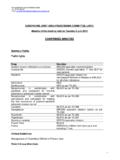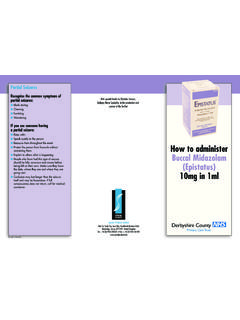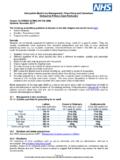Transcription of Chronic Obstructive Pulmonary Disease (COPD) …
1 copd Management Updated August 2019 Review: July 2022 Page 1 of 20 Chronic Obstructive Pulmonary Disease ( copd ) Management Update of copd guidance based on NICE NG115 (Dec2018). This replaces NICE CG101. Diagnosis of copd should be considered in patients over the age of 35 who have a risk factor (generally smoking or a history of smoking) presenting with exertional breathlessness, Chronic cough, regular sputum production, frequent winter bronchitis or wheeze. The fundamentals of copd care include: o Offering support and treatment to stop smoking o Offer Pulmonary rehabilitation o Offering pneumococcal vaccination and an annual flu vaccination o Co-develop a personalised self-management plan (respiratory action plan) o Optimise treatment for co-morbidities All of the above should be offered before commencing pharmacological treatment and reviewed at each patient contact.
2 NICE recommends commencing inhaled therapies only if all the above interventions have been offered (if appropriate) and inhaled therapies are needed to relieve breathlessness or exercise limitation or the patient has had exacerbations. Before stepping up treatment to the next stage in the therapeutic management of copd , the patient s inhaler technique, compliance with administration instructions and tolerance of the current device should be checked. Combination inhaled therapy with LABA/LAMA is recommended for patients who remain breathless or have exacerbations despite treatment and present with no asthmatic features or features suggestive of steroid responsiveness.
3 (See algorithm p8 for further details). LABA/ICS combination inhalers are recommended for patients with asthmatic features or features suggestive of steroid responsiveness. NICE consider triple therapy (as a single inhaler) to be a cost-effective strategy compared to LABA/LAMA and LABA/ICS in patients who continue to exacerbate or remain breathless on dual therapies. Conduct a clinical review before commencing triple inhaled therapy to ensure that all non-pharmacological copd interventions have been optimised and that acute episodes of worsening symptoms are caused by copd exacerbations and not by other physical or mental health conditions. Features from the history and examinations should be used to differentiate copd from asthma whenever possible.
4 DERBYSHIRE JOINT AREA PRESCRIBING COMMITTEE (JAPC) copd Management Updated August 2019 Review: July 2022 Page 2 of 20 Document update Date Insert NICE clinical review of triple therapy to as key message Sept19 Changed the order for fobumix and fostair in management flowchart to be in line with traffic lights and removed the following words option if copd + Asthma overlap from the LABC/ICS box. Oct 19 Advice on roflumilast added Aug 20 Insert Trixeo and Bevespi June 21 Addition of Luforbec/ Trimbow NEXT haler Sept 21 Hierarchy of inhalers updated to promote greener prescribing Oct 21 Salamol MDI as preferred choice salbutamol MDI (lower carbon footprint)
5 Nov 21 Contents Key copd Chronic Obstructive Pulmonary Disease SABA short - acting beta2 agonist sama short - acting muscarinic antagonist LABA Long- acting beta2 agonist LAMA Long- acting muscarinic antagonist ICS Inhaled corticosteroid FEV1 Forced expiratory volume in 1 second FVC Forced vital capacity BMI Body Mass Index copd Management Updated August 2019 Review: July 2022 Page 3 of 20 Contents Definition .. 4 Diagnosis .. 4 Spirometry .. 4 Reversibility testing .. 4 Symptoms .. 5 Breathlessness .. 5 Airflow Obstruction .. 5 Effective copd interventions .. 5 Smoking cessation .. 5 Pulmonary rehabilitation.
6 6 North Derbyshire .. 6 South Derbyshire & Erewash .. 6 Vaccinations .. 6 Respiratory action plans (RAP) .. 6 Follow-up for copd patients in primary care .. 7 Management of stable copd .. 8 Key messages for prescribers .. 9 Inhaled 10 1. SABA or sama .. 10 2. LABA + LAMA combinations .. 10 3. LABA + ICS combinations .. 10 4. LABA + LAMA + ICS .. 11 Choice of drugs/inhalers .. 11 Other therapies .. 11 Roflumilast .. 11 Oral corticosteroids .. 12 Osteoprotection .. 12 Oral prophylactic antibiotic therapy .. 12 Theophylline .. 13 Mucolytics .. 13 Anxiety and depression .. 13 Managing exacerbations .. 13 Appendix 1: Inhaled corticosteroids .. 14 Appendix 2: Spirometry.
7 14 Appendix 3: Oxygen therapy .. 15 Appendix 4: Cost comparison .. 16 copd Management Updated August 2019 Review: July 2022 Page 4 of 20 Definition Chronic Obstructive Pulmonary Disease ( copd ) is a Chronic slowly progressive disorder, characterised by airflow obstruction, which does not change markedly over several months. The impairment in lung function is largely fixed but may be partially reversible by bronchodilators or other therapy. Most cases are caused by tobacco smoking, though lifelong non-smokers may develop copd probably related to occupation. Diagnosis The diagnosis of copd depends on thinking of it as a cause of breathlessness or cough.
8 The diagnosis is suspected on the basis of symptoms and signs and is supported by spirometry. Diagnosis of copd should be considered for: Patients >35 years and Smokers (or significant dusty occupation) and patients who present with one or more of the following: o Exertional breathlessness o Chronic cough o Regular sputum production o Frequent winter bronchitis o wheeze Spirometry Spirometry is one of the essential lung function investigations in the diagnosis, severity assessment and monitoring of Disease progression of copd . It should be performed to a high standard, quality assured and only performed and interpreted by professionals assessed as competent against ARTP standards.
9 Once certified healthcare professionals should record their qualification on National Register of certified professionals and operators which is a new framework being implemented Nationally over four years from 1st April 2017 to 31st March 2021. Further investigations for all patients at initial diagnostic evaluation Chest radiograph to exclude other pathologies FBC - to identify anaemia or polycythaemia BMI calculated Eosinophilia Reversibility testing Key to an accurate diagnosis for copd is based on signs and symptoms, supported by spirometry. Therefore in most patients, routine spirometric reversibility testing is not necessary as part of the diagnostic process or to plan initial therapy with bronchodilators or corticosteroids.
10 Untreated copd and asthma are frequently distinguishable on the basis of history in people presenting for the first time. Features from the history and examinations should be used to differentiate copd from asthma whenever possible. Clinical features differentiating copd and asthma copd Asthma Smoker or ex-smoker Nearly all Possibly Symptoms under age 35 Rare Often Chronic productive cough Common uncommon Breathlessness Persistent and progressive Variable Night-time waking with breathlessness and/or wheeze Uncommon Common Significant diurnal or day-to-day variability of symptoms Uncommon Common copd Management Updated August 2019 Review: July 2022 Page 5 of 20 To help resolve cases where diagnostic uncertainty remains, or both copd and asthma are present use the following findings to help identify asthma.










